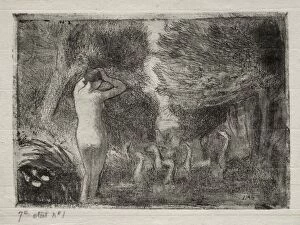Camille Pissarro French Collection
Camille Pissarro, a renowned French artist from the 19th century, left an indelible mark on the art world with his diverse and captivating works
All Professionally Made to Order for Quick Shipping
Camille Pissarro, a renowned French artist from the 19th century, left an indelible mark on the art world with his diverse and captivating works. Born in 1830 and passing away in 1903, Pissarro's artistic journey spanned several decades, during which he created masterpieces that continue to captivate audiences today. One of his notable pieces is "Wooded Landscape at LHermitage, Pontoise" painted in 1879. This painting showcases Pissarro's ability to capture nature's beauty with its vibrant colors and meticulous brushstrokes. Similarly, "The Mender, " created around 1881, portrays a scene of everyday life with remarkable attention to detail. Pissarro was also known for his cityscapes such as "Quai Boieldieu in Rouen" (1896) and "Rue Damiette, Rouen" (1884). These paintings depict bustling streets filled with people going about their daily routines. Through these urban landscapes, Pissarro showcased his keen observation skills and talent for capturing the essence of a place. In addition to landscapes and cityscapes, Pissarro explored various themes including peasant life. Works like "Peasants Carrying Fagots" (1896) and "Group of Peasants" (1896) portray scenes of rural laborers engaged in their daily tasks. These paintings reflect both the hardships faced by peasants as well as their resilience. Pissarro also ventured into portraiture with pieces like "Paul Cezanne" (1874), showcasing his ability to capture not only physical features but also the personality of his subjects. Furthermore, "Nude Women" (1896) demonstrates Pissarro's skillful depiction of human form through delicate brushwork. Throughout his career, Pissaro experimented with different styles while remaining true to Impressionism- characterized by its emphasis on capturing the fleeting effects of light and color.

















